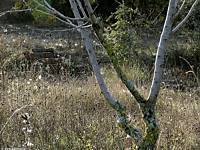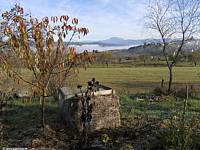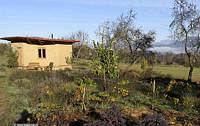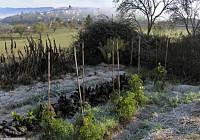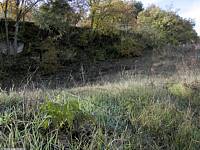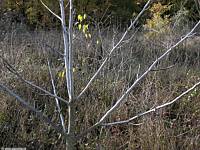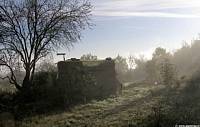|
|
Nature Switched On
|
|
|
introduction
Overview of the vegetable garden with the fast growing Almond
tree on the right. |
Our outdoor thermometer is about 1 meter above
ground level and hasn't registered temperatures below zero yet, but
wate Some fruit trees have lost all their leaves while others are
still green as if it were still summer. Time for a brief account of
the different behaviours of the fruit trees. There is an Almond tree in the middle of the vegetable garden
which is now practically leafless but has shown vigorous growth over
the last years, surely due to the thick mulch layer. But alas, its
almonds split open spontaneously and rot away (or are eaten away) before harvest time
and I won't be surprised if this is caused by all too favourable
humidity conditions, adapted as the tree is to drought.
The apple tree ('Starking Delicious') is as green as ever,
while the pear ('Conference') is starting to turn yellow. The
Black mulberry trees are still green as well but something special
happened last year with one of them.
|
Mist is a constant feature now every morning, sometimes swallowing our zone as well. 9 Nov 9:04 |
|
Mulberry tree on the left, Apple
tree in the middle, Pear tree on the right. Barley just germinating in the background. 28 Nov 10:47 |
||
|
November last year the Black mulberry tree on the right not only withered prematurely but even seemed to die, until we discovered a new sprout at its base in late spring the following year. This sprout started to grow at an impressive rate and has now reached a height of more than 2 metres! This sprout comes from the roots on which the original tree was grafted and will probably not produce a lot of useful fruit but the plant has beautiful big green leaves wchich will produce a very useful shadow in front of the house. Its vigorous spontaneous growth is also perhaps preferable to the somewhat static, polelike constitution of his grafted nephews. |
||
| Photograph taken on 18 Nov 2010 (14:51) with the brown leaves of the Mulberry tree on the right. The one on the left is still green. | ||
|
The new offshoot on the same
Mulberry tree. The old trunk serves as support. 28 Nov 10:49 |
||
|
|
Most fruit trees will receive the regular pruning in the coming
weeks. The mature Almond trees on the other hand are mostly left
alone, as they have never been pruned before and look quite nice and
natural that way. |
|
|
Lichen growth shows clearly the
different pruning stages of this young almond tree. The white tufts in the background are cobwebs, the black ones are fruit clusters of Wild carrot. 28 Nov 12:46 |
||
|
Quince tree in the centre. |
The Cherry tree is beautiful in the autumn light and has grown a lot this year, taking advantage of the nearby compost heap.
Still green and showing good health are the
Quince (Cydonia oblonga
'Gigante de Vranja') and the
Peach tree ('Calanda'), although they haven't produced any
significant fruit so far, which is tr |
Cherry tree with the
compost heap. We harvested quite some cherries this year. |
|
|
From left to right: Jerusalem
artichoke, Leek, Swiss chard, Tomatoes. At the back, still green,
the Peach tree. 28 Nov 10:51 |
|
|
More than once I observed a notable difference in the shedding of leaves between young trees and older ones. An extreme example these days are the different Walnut trees in the zone. The younger one (about 2 years old) was growing spontaneously in the vegetable garden and I replanted it somewhere else with quite some straw around it to survive the summer. Well, I can now say that it did more than survive and is still as green and fresh as in spring. The older Walnut trees have all shed their leaves by now. |
||
|
The young Walnut tree in the south corner of the zone. 28 Nov 12:52 |
An older Walnut tree which has
begun to produce nuts this year so it must be over 10 years old. 28 Nov 12:48 |
|
|
|
|
The Loquat tree in front of the greenhouse. |
|
introduction
|
|
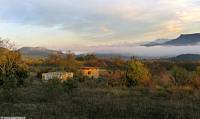
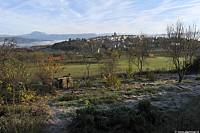
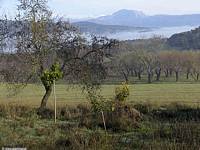
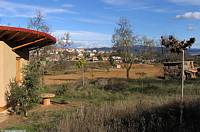
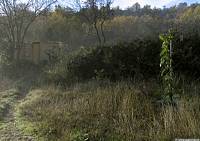
_to_treat_a_tree_thm.jpg)
